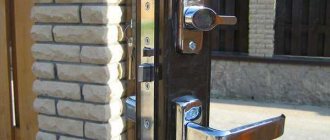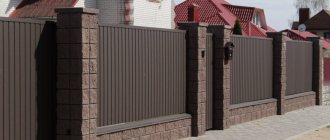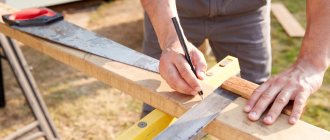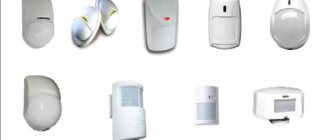It is difficult to imagine the arsenal of tools of a home craftsman or mechanic without a hand saw. Another name for it is a hacksaw. With this tool you can cut down branches in the garden, shorten pickets for a fence and do a lot of other work where you need to change the length of a wooden product: laminate flooring, farm boards, etc.
You may not have thought about it, but the correct choice of a hacksaw determines not only its service life, but also the ease of use and quality of the cut. Let's consider the main parameters of the correct choice of this tool, which is necessary for household and carpentry activities.
Criterias of choice
The main purpose of a hand saw is longitudinal or cross cutting of wood, as well as materials based on it or similar in properties. When choosing a tool, the following series of parameters are primarily taken into account:
- Purpose.
- Teeth parameters.
- Blade steel type.
- Length and geometry of the canvas.
- Handle shape.
Let us analyze in detail the features of choice for each of them.
Purpose
The first thing you need to know in order to choose the right hacksaw for wood is the type of work performed with it. At the same time, they are classified according to two criteria - type of cut and purpose. According to the nature of the cut, hand saws are divided into 3 main types:
- Longitudinal. They are equipped with teeth with a sharpening angle of about 45-60 degrees. Provides a unidirectional, uniform, precise cut. Therefore, they are used for finishing, in the manufacture of furniture and interior items.
- Transverse. They are characterized by a tooth sharpening angle of the order of 45-55 degrees. Used for cutting in both directions, mainly on dry material.
Cross cutting of a wooden blank Source domnomore.com
- Universal. The blade has two types of teeth - semicircular and triangular. The first ones set the direction of movement, the second ones expand the seam. The closer the teeth are located to each other, the higher the cutting accuracy.
According to their purpose, hand saws are classified into classic, tenon and circular saws. The former are used as a standard, the latter - for the formation of technological tongue-and-groove joints, the latter - for creating rounded shapes and holes.
Teeth parameters
The second important criterion when choosing a saw is the parameters of the teeth. This is primarily their size, which is also directly related to the distance between their tips - the pitch. There are three main groups:
- Small ones. The tooth size is 2-2.5 mm. In this case, the number of teeth (TPI index) for a given length (usually an inch) is 7-9. Used for high-quality precision cutting.
- Average. The teeth are 3-3.5 mm in size. The TPI indicator is 5-7. Used in carpentry work.
- Large ones. The dimensions of the teeth reach 4-6 mm. TPI – 3-5. A wood hacksaw with a large tooth is used for rough work - cutting firewood, building materials - when high speed is required.
Hand saw for wood with large teeth Source domnomore.com
On a note! Modern models of hand saws have a cutting part structure in which teeth alternate with voids. This makes it possible to use the tool on both dry and wet wood. When cutting fresh wood, wet sawdust can be easily removed through the gaps. Thanks to this, the saw does not get stuck and gets the job done quickly.
Blade steel type
Despite the fact that the wood saw is used in mild conditions, its blade is still made of high-quality steel alloys. These are mainly brands such as - 8ХФ, 65Г, У7 - У10, etc. Their main feature is wear resistance, achieved by the inclusion of silicon and carbon in the composition.
However, in order to save money, some manufacturers make blades from ordinary steel and make the cutting part high-strength. Moreover, if the teeth have a hardened structure, which is usually reflected in their characteristic black color, then after inevitable wear they cannot be repaired. At the same time, analogues made of non-hardened steel can be periodically undermined as they wear out.
Sharpening the cutting part of a hand saw for wood Source domnomore.com
See also: Catalog of companies that specialize in finishing materials and related work
Length and geometry of the canvas
In order to choose the right wood hacksaw for optimal and fast sawing in accordance with specific application conditions, it is necessary to take into account the length of the blade. This parameter, as a rule, has a direct relationship with the characteristics of the pitch and size of the teeth, and divides saws into 3 main categories:
- Narrow canvas 250-350 mm long. Equipped with small, frequently spaced teeth.
- Universal saw with a blade of 350-550 mm. Has medium sized teeth.
- Wide canvas with a length of 550-650 mm. equipped with large teeth with increased pitch.
The geometry of the canvas can also vary depending on the purpose. Thus, standard saws have the shape of a beveled rectangle. Special models are equipped with a curved canvas. For example, a branch cutter has the shape of a curved saber, which makes it easy and convenient to work with when trimming garden trees and shrubs.
To trim branches of garden trees, it is convenient to use a specially shaped saw Source domnomore.com
Important! When choosing a saw for specific application conditions, the ratio of the length of the blade and the thickness of the workpiece is not the least important. It should be at least 2 times larger. Otherwise, it will be inconvenient for her to saw: the amplitude of the cut will be insufficient, and the blade will constantly jam.
Handle shape
The shape and size of the handle can have a wide variety of variations - this depends on the type of work being carried out, conditions, anthropometry and user requirements. The main thing is that it is comfortable, fits ergonomically in your hand and does not slip.
Recommendation! For thrifty owners, when equipping a home workshop, the best option for a wood hacksaw would be a model with removable blades. It takes up less storage space and ultimately costs much less than a whole set of hand saws for each application.
Materials for making a hacksaw
To simplify the task for amateur gardeners and beginners in carpentry, hacksaw manufacturers use appropriate markings that indicate what material was used.
HCS - carbon steel blades. These are the cheapest and least durable products, so they are mainly used for cutting soft materials such as wood or wood-based materials.
CV - chrome vanadium steel is used for their manufacture. The blades are of slightly higher quality than HCS tools.
HSS - made of high-speed, high-alloy steel, they are highly durable, so they can be used not only for wood, but also for metal.
BiM - produced by connecting an HSS belt to an HCS belt. As a result, the saw blades are very strong and at the same time flexible. Thanks to their extended service life, they can be used for long periods of time cutting both wood and metal.
HM/TC - the saw blade body is made of carbon steel (HCS), and the working part is made of carbide (fine or coarse grain). It is used primarily for cutting the hardest materials, as well as materials that are difficult to cut (such as glass). This hacksaw cannot be used on wood.
Varieties
There are the following main types of hand saws for wood:
- Classic. Characterized by a standard design of the canvas. Can have any number of teeth. It is used for a wide range of works - construction, carpentry and carpentry, in everyday life.
The most common type of hand saw for wood Source mosoblzhilservis.rf
- Narrow. It has a characteristic narrow blade, sometimes with double-sided teeth. Used for cutting out holes and contours of complex shapes.
- With a butt. The design of the blade has an additional stiffening rib - on the edge opposite the cutting part. Thanks to it, the saw does not bend under heavy load. A characteristic feature is that the cutting depth is limited by the width of the working part of the blade.
- Luchkovaya. The base uses a thin canvas, secured at the edges with a bow-shaped handle. Pros - the ability to carry out a number of complex works, the complexity of which corresponds to processing on machines. Disadvantages: inconvenience of use, fragility, large dimensions.
- Reward. Saw – with the characteristic profile of a hand plane. The main purpose is to cut out the elements of the tongue-and-groove connection.
- Foldable. A small-sized saw, the cutting part of which, when folded, is placed in the groove of the handle. It is used in hiking, tourism and other field conditions.
Mini folding hacksaws Source domnomore.com
Reference! There are also other, specific types of wood saws with a narrow profile purpose. Prominent among them are a garden saw with reverse teeth for conveniently cutting branches, a two-handed saw for quickly sawing logs, and a compact chain model for tourism.
Which is better
The best features of a hacksaw are controversial. They depend on the purpose for which the tool will be used.
- It is easier to saw the material if more than ten teeth are involved in the cut.
- The process will happen faster if the hacksaw has large teeth. But at the same time, the edge of the cut comes out uneven. This is due to excessive vibrations arising from too few teeth simultaneously engaged.
- Small teeth are sawed more slowly due to complications in removing sawdust, but the edge of the cut is much smoother and cleaner.
- The handles must be rubberized. They are more convenient to work with, they do not rub and, when used for a long time, do not cause unpleasant sensations when interacting with the skin.
- Hardened teeth are more durable.
TOP best models
The TOP 5 modern hand saws for wood are represented by the following models:
- Bahco 2600-16-XT11-HP. The saw copes equally effectively with transverse and longitudinal cuts. The canvas has a special coating against friction forces. Equipped with resistant teeth and an ergonomic non-slip handle. Weighs less than 0.5 kg. The only negative is the high price.
Hand saw for wood Bahco line Source insales.ru
Guarantee
You can return or exchange the instrument within 14 days if the following conditions are met:
- there are no signs of use on the hacksaw: chips, scratches and abrasions;
- the box was opened carefully and not damaged;
- if the set included accessories (cases or additional sheets), they are all in place;
- Labels and factory marker are not erased.
Many manufacturers are so confident in the quality of their products that they offer a lifetime guarantee.
This concept means:
- maintenance of the hacksaw throughout its entire service life;
- free repairs are carried out if the breakdown occurred due to the fault of the factory;
- Blades and nuts damaged during operation are not covered by the warranty service - these are consumables.
Video description
Video on how to choose the right hacksaw for wood:
- Stanley Jetcut 2-15-283. This hand saw model was included in the rating of hacksaws for wood as the best among universal ones. Thanks to the 3-sided sharpening of the teeth and a fairly long blade - 45 cm - the tool allows you to saw almost any workpiece without clamping. Disadvantage: the cut is not of very high quality and is not suitable for processing finishing parts.
- BAHCO LAPLANDER 396-LAP. Folding universal saw. Application – construction, tourism, hunting, fishing, gardening. The universal shape of the teeth allows you to cut wood both lengthwise and crosswise. Canvas length 23 cm.
Note! When choosing a saw, it matters how often it will be used. For periodic use, a model with hardened teeth is suitable; for frequent use, it is better to use one made of standard steel, since inevitable grinding will require constant updating of the cutting part, which cannot be done with an analogue made of hardened material.
Problems and difficulties
The disadvantages of hacksaws depend on the manufacturer and the craftsman who uses them. The main ones can be identified:
- quality manufacturers have a narrow range;
- hard wood species can damage the panel;
- the cheapest hacksaws are not re-sharpened;
- when choosing large teeth, the cuts are inaccurate;
- if the handle is not rubberized, it is inconvenient to work;
- may react negatively to humidity, but this depends on the material of the panel;
- The warranty does not apply to consumables.
Briefly about the main thing
A hand saw allows you to efficiently, quickly and safely saw wood, as well as materials based on it and analogues with similar characteristics. When choosing a tool, the following parameters are taken into account:
- Purpose.
- Size, pitch, type of teeth.
- Type of fabric material.
- Length and shape of the canvas.
- Type of handle.
There are the following types of saws for wood: classic, narrow, with a back, bow, award, folding. The TOP 5 best models included: Bahco 2600-16-XT11-HP, Gross Piranha 24109, BISON EXPERT, Stanley Jetcut 2-15-283 and BAHCO LAPLANDER 396-LAP.
Ratings 0
Hacksaw blades
Blades differ from each other mainly in their design and the material from which they are made.
Tooth geometry
There are four types of teeth on a hacksaw:
- wavy - used for straight cutting,
- inclined ones are used for the most precise cutting,
- large ones are distinguished by very fast and smooth operation. However, the disadvantage of this type of teeth is that they can leave a rough cut, that is, a mark on the material;
- fine with open sharpening - provides fast rough cutting.
Tooth spacing
Also called pitch, the smaller the gap, the more teeth working simultaneously in the material. This in turn makes the cutting process smoother and vibration-free. For metal saw blades the distance is about 1.2 mm, and for wood products it increases to about 4 mm.
Blade thickness and width
The thickness of the blade affects the processing accuracy and durability of the tool itself. The thicker the blade, the stiffer it is and the more accurate the cut is possible (only straight and at a slight angle). The width of the blade also plays an important role.
If it is necessary to make curved cuts, purchase a narrow blade (about 4 mm), which can be easily maneuvered. Wide blades are used for straight cutting only.
Handle type
There are three types of blades on the market based on handles, that is, according to the method of attaching the handle and hacksaw. This can be a universal or T-shaped mount.
What can break
The most common things that break in hacksaws are:
- teeth;
- whole canvas;
- pens.
In the first two cases, it is necessary to completely replace the panel. Each manufacturer has an assortment of canvases designed for each model. You can secure them yourself. As a rule, the canvas comes with mounting instructions.
Handles most often cannot be repaired; in this case, the hacksaw will have to be replaced.
Handle type
In many ways, the ease of use of a tool is determined by the shape and material of its handle. Handles can be wooden or plastic. The surface at the grip site should not allow the hand to slip. This effect is eliminated by making scars on the handle, or covering it with a rubber layer. The saw can be cast or with a reversible blade. In the latter case, it is easy to replace the canvas.
Conventional handles are made of plastic. Prefabricated plastic handles of two halves do not have sufficient rigidity; it is much more convenient to handle a tool with a one-piece handle with a rubberized backing for the fingers. The rubber insert allows for a tighter grip, which prevents the formation of calluses.
Canvas size
Depending on your task, you can choose different blade lengths. For simple boards and small bars, a length from twenty-eight to thirty centimeters is quite suitable. If construction work is underway, then it would be wiser to take a canvas from forty-five to fifty centimeters long.
The basic rule: the length of the product should be half the length of the hacksaw itself, otherwise you can forget about ease of use.











